
-
東京駅『丸の内駅舎』 / TOKYO STATION MARUNOUCHI STATION BUILDING
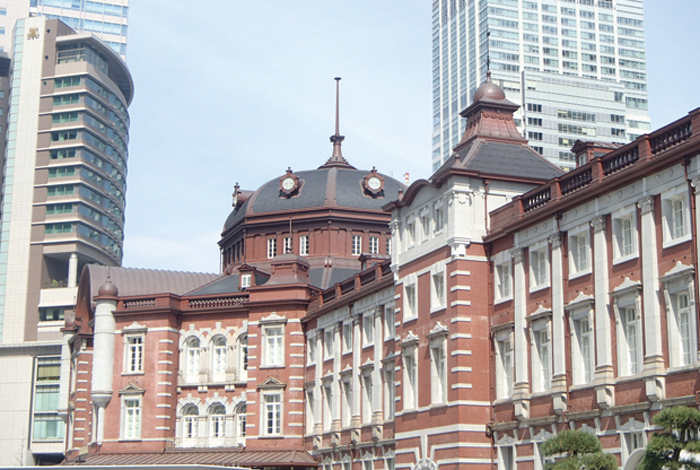
1914年12月14日に完成した東京駅。正面長334.5m、左右に巨大な2つのドームを持つ荘重な駅舎は、当時の日本建築界の第一人者である辰野金吾氏設計のもと、6年半もの歳月と、莫大な予算をかけて建設された国家プロジェクトでした。100年の時を経て現代に生まれ変わった東京駅丸の内駅舎保存・復原工事の最大の特徴は、復元ではなく、復原であること。創建当時の姿に戻すために、当時の材料や工法を駆使しています。たとえば、丸の内駅舎のシンボルともいえる赤レンガ。保存される100年前のレンガと現代のレンガとの、色合いの違いを違和感なく調和させるデザイン上の工夫が取り入れられています。また、屋根は天然スレートと銅板の構成で葺かれていますが、こちらも創建時の古い写真から天然スレートは全て一文字葺きで葺かれていることが判明し、それをもとに復原しています。中央部の屋根には、創建時に使用されていたものと同様、宮城県雄勝産スレートを葺いています。細部までこだわり抜いて復原された東京駅丸の内駅舎。このフィギュアでは、丸の内中央口から丸の内北口までを再現しています。フィギュアを手に、是非実際に駅舎を訪れて、じっくりと駅舎鑑賞を楽しんでみてください。
Tokyo Station was completed on December 14, 1914. The majestic station building with two giant domes on each side a facade that is 334.5 meters long was a national project constructed with an enormous budget over a period of six-and-a-half years based on the designs of Kingo Tatsuno, the foremost Japanese architect of the time. The biggest characteristic of the preservation and restoration work undertaken on the Tokyo Station Marunouchi Station Building—now reborn after a century—is that the endeavor involved restoration rather than reconstruction. To restore the station to the way it looked when it was first constructed, materials and construction techniques employed at the time have been used. One example is the red bricks that are regarded as a symbol of the Marunouchi Station Building. Ingenuity in design has been incorporated to blend the differences in color between bricks preserved from a hundred years ago with modern bricks without looking out of place. In addition, while the roof has been tiled with a configuration of natural slate and copper sheeting, based on old photographs from when the building was first constructed, it was determined that the natural slate was all tiled using the Dutch-lap method, and this was also restored to its original state. The center part of the roof was tiled with the same slate from Ogatsu in Miyagi Prefecture that was used during the original construction. In this way, the Tokyo Station Marunouchi Station Building was restored with attention to the finest details. This figure recreates the area from the Marunouchi Central Exit to the Marunouchi North Exit. With this figure in hand, why not visit the real thing and take the time to view the station building in all its splendor?
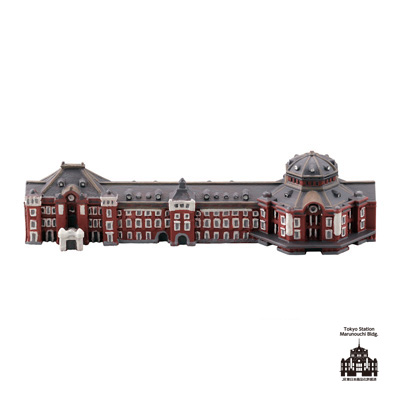
原型制作:渡辺結樹
造形企画制作:株式会社 海洋堂 / 発売日:2016年2月12日 / 価格:1回 400円(税込) / 種類:全6種
-
上野動物園『ジャイアントパンダ』 / UENO ZOO GIANT PANDA

上野駅は1883年に開業し、2013年に開業130周年を迎えました。現在の駅舎は、1932年に建設された三代目駅舎が原型となっており、増築や改修を重ねながら大切に使われてきました。そのため、構内の至るところで昭和の面影を感じることができます。中央改札を出て左手にあるアトレ上野レトロ館2階回廊部では、柱や天井のレリーフなどに凝った意匠を見ることができます。広い構内にはその他にも絵画や銅像などが点在しています。たとえば、中央改札の真上に描かれた巨大な壁画は猪熊弦一郎の作品。北の玄関口と言われる上野駅に因んで、北日本の観光や風物を主題とした10の物語が描かれています。そして、駅だけでなく、街へ一歩踏み出せば、史跡、芸術、動物など多彩な魅力を放つ上野。その中でも、今や、「上野と言えばパンダ!」と言えるほど、1972年に初お目見えして以来、パンダは常に上野の街のアイコンとして多くの人の心をつかんでいます。駅構内にも街の中にも、よく目を凝らすと至るところにパンダがたくさん。パンダ探しをしながら探索するのも上野の楽しみ方の一つです。
Ueno Station opened in 1883 and observed its 130th anniversary in 2013. The original form of the current station building was the third-generation station building constructed in 1932, which has been used with care through various extensions and renovations undertaken over the years. For this reason, every corner inside the station evokes images of the Showa era. At the covered walkway on the second floor of Atre Ueno Retro Hall, located on the left after exiting the central ticket gates, the design featuring pillars and ceiling reliefs can be seen. The vast interior is also dotted with paints and statues. For example, a large mural pained directly above the central ticket gates is a work by Genichiro Inokuma. The mural depicts ten stories themed after the sights and scenery of northern Japan associated with Ueno Station, which is known as the gateway to the north. Of course, Ueno is not just a station. A brief walk into the town reveals all manner of charms from historical sites and art to different animals. Among these attractions, since Ueno Zoo welcomed its first panda in 1972, Pandas have become a symbol synonymous with Ueno and captured the hearts of countless visitors. If you look carefully, images of pandas can be seen everywhere, both inside the station and around the town. Exploring the town while searching for pandas is one way to enjoy Ueno.

原型制作:田熊勝夫
造形企画制作:株式会社 海洋堂 / 発売日:2016年2月12日 / 価格:1回 400円(税込) / 種類:全6種
-
上野あんみつ『みはし』 / ANMITSU MIHASHI

1948年3月、まだ戦後の混乱が残る上野公園前にあんみつ屋として創業した「あんみつ みはし」。店名の「みはし」は、創業時のこの地の町名が由来となっています。上野広小路一帯が東叡山寛永寺の領地だった頃に、寛永寺への参道を不忍池からの川が横切り、3つの橋が架かっていたことから、三橋(みはし)という町名になったそうです。戦後まもない東京は、農業生産力も低下して、食糧不足が深刻な時期でした。食糧管理法や配給統制法により、砂糖や小豆の入手に大変苦労したそうで、その分、お汁粉やあんみつは大いに喜ばれ、お店は大繁盛だったそうです。看板商品の白玉クリームあんみつは、北海道十勝地方の良質な小豆を使って作られた餡と、さらりとした甘さの蜜に、さっぱりとしたミルクのやさしいソフトクリームが相性抜群。上野・御徒町を散策した後は、みはしの甘味でほっとひと時。時代を経ても愛され続けています。
Anmitsu Mihashi opened in front of Ueno Park as a store selling anmitsu (a traditional Japanese dessert made from agar jelly, azuki bean paste and other ingredients) in March 1948, when Japan was still affected by the post-war chaos. The “Mihashi” in the store name is derived from the name of the town in the area when the store opened. Back when part of the Uenohirokoji area comprised the grounds of the Toeizan Kanei-ji Temple, the approach to the temple was intersected by a river flowing from the Shinobazu Pond, and since three bridges were erected over the river, the town was named Mihashi (literally, “three bridges”). Soon after the war, Tokyo underwent a period where agricultural production declined and food shortages became serious. Due to the Staple Food Control Act and Distribution Control Act, it became extremely difficult to obtain sugar and azuki beans. In part due to this, people delighted in the shiruko (sweet red-bean soup with mochi) and anmitsu on offer, and the shop did great business. Shiratama (rice flour dumpling) Cream Anmitsu, the store’s signature product, perfectly blends a bean jam made with high quality azuki beans from the Tokachi region in Hokkaido together with a smooth and sweet syrup and a gentle, soft cream from refreshing milk. After taking a walk around Ueno and Okachimachi, take a moment to recharge with the sweet taste of Mihashi. The store continues to enjoy a devoted following that transcends time..

原型制作:寺岡邦明
造形企画制作:株式会社 海洋堂 / 発売日:2016年2月12日 / 価格:1回 400円(税込) / 種類:全6種
-
渋谷駅『ハチ公』 / SHIBUYA STATION HACHIKO STATUE
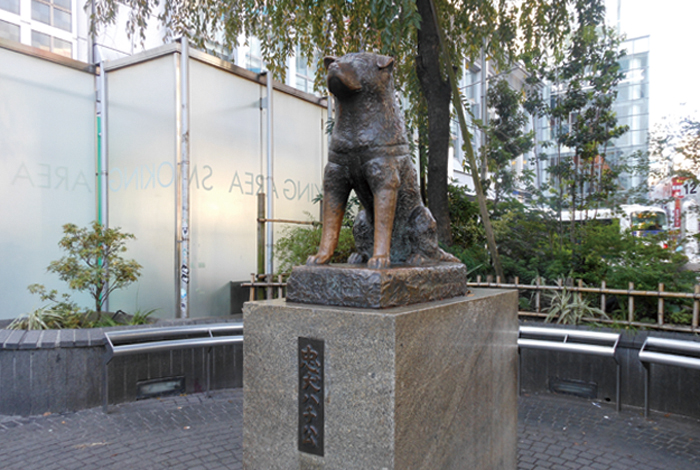
渋谷駅は、1885年に、赤羽から品川を結ぶ、日本鉄道品川線(現在の山手線の一部)の駅の1つとして開業しました。関東大震災後、山手線の西側に住宅街が広がり、東急東横線、井の頭線が開通し、渋谷駅は一大ターミナル駅となりました。渋谷駅の待ち合わせ場所として有名な「忠犬ハチ公像」のモデルである、「ハチ」が渋谷駅に現れるようになったのは、ちょうどこの頃です。飼い主が亡くなってからも渋谷駅の改札で、その帰りを待ち続けたというストーリーは、今では世界的にも知られています。当時、渋谷駅近辺ではハチ公せんべい、ハチ公チョコレートなどがお土産で売られたほど「ハチ公」人気はとどまらず、ついに渋谷駅改札付近に初代「忠犬ハチ公像」が建てられました。生前に銅像が造られるのは、当時、前代未聞のことだったようです。初代のハチ公像は、戦時中の金属供出で撤去・解体されてしまい、現在のハチ公像は1948年に建設された2代目です。2013年には私鉄5社による相互乗り入れが開始され、渋谷駅はこれからも、ますます発展していきます。そして、渋谷の街も最先端の情報と文化を発信し続けています。このフィギュアでは、変わりゆく渋谷を長い間見つめ続けてきた「忠犬ハチ公像」を再現しました。あなたも“ハチ公前”で待ち合わせをして、渋谷の街を楽しんでみてください。
Shibuya Station opened in 1885 as a stop on the Nippon Railway Shinagawa Line (part of the present-day Yamanote Line) that linked Akabane and Shinagawa. After the Great Kanto Earthquake, residential areas expanded out to the west side of the Yamanote Line. Two new lines serving the station opened, namely the Tokyu Toyoko Line and Inokashira Line opened, and Shibuya Station became a large terminal station. It was around this time that Hachi, the dog that was the model for the “Loyal Dog Hachiko” statue that has become a famous meeting place around Shibuya Station, appeared at Shibuya Station. The story of the dog, who continued to await its master’s return at the Shibuya Station ticket gates even after the man had passed away, is today known around the world. At the time, Hachiko continued to be so popular that souvenirs such as Hachiko senbei (baked rice crackers) and Hachiko chocolate would be sold around Shibuya Station, and finally the first “Loyal Dog Hachiko” was constructed near the Shibuya Station ticket gates. At the time, it was unprecedented for a statue to be created while its subject was still alive. The first Hachiko statue was removed and broken up for its metal during the Second World War. The current statue is the second one, constructed in 1948. In 2013, mutual track sharing between five private railways commenced, and Shibuya Station looks set to develop even further in the future. What’s more, the town of Shibuya continues to be at the forefront of the latest information and culture. This figure recreates the “Loyal Dog Hachiko,” which has continued to watch over the ever-changing Shibuya for many years. Try arranging your own meeting in front of Hachiko before enjoying all that Shibuya has to offer.
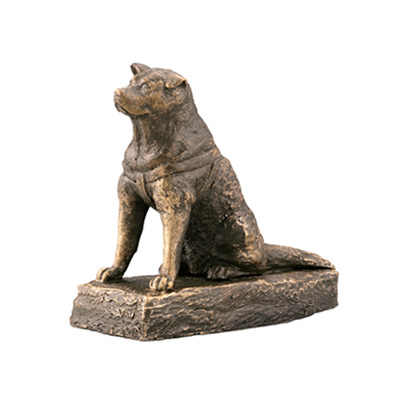
原型制作:森岡一基
造形企画制作:株式会社 海洋堂 / 発売日:2016年2月12日 / 価格:1回 400円(税込) / 種類:全6種
-
秋葉原駅『秋葉原電気街』 / AKIHABARA STATION ELECTRIC TOWN
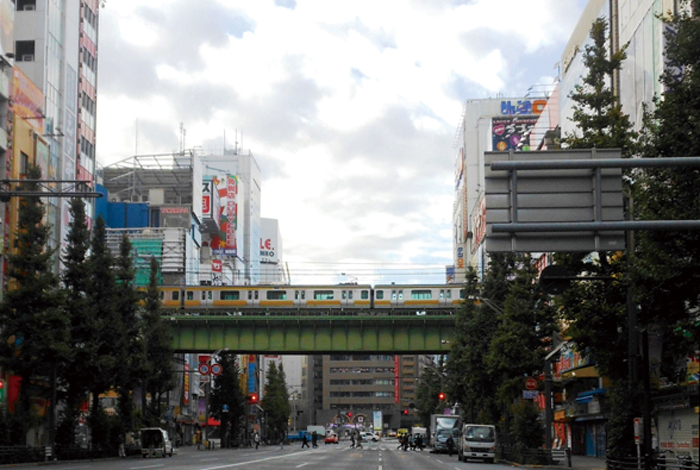
秋葉原駅は1890年に、秋葉原貨物取扱所という貨物専用駅として誕生し、山手線と総武線が交差する、交通の結節点として発展してきました。このフィギュアでは、秋葉原駅と御茶ノ水駅とをつなぐ総武線の高架橋と、電気街を再現しています。秋葉原駅は、当時の最先端の技術を駆使して作られた高架駅でした。戦後、復員した元通信兵たちが、この高架下でラジオ部品等の露店を営むようになり、これが今の電気街の原型の1つとなったそうです。高架橋と電気街には、そんな関係があったのですね。時は流れ、メイド喫茶やAKB劇場、ガンダムカフェなど新たなカルチャーを生み出し続ける秋葉原。一方で須田町の方面に足を伸ばせば、神田の小粋な文化が生き生きと感じられ、御徒町方面へ行けば「2k540」などクリエイティブな施設を楽しむことができます。様々な路線が立体交差している駅が示すとおり、秋葉原は幅広い文化、そして時代をつなぐ場所でもあるようです。さて、ここで余談ですが、JR秋葉原駅の会議室には、防火の神様で知られる「秋葉神社」の分社が大切に祀られています。これは、現在の秋葉原周辺が、江戸時代に大火事の火元となることが多く、現在の駅構内にあたる場所に「鎮火神社」(後に「秋葉神社」となる)が設けられた、その名残なのです。駅構内には様々な施設がありますが、まさか神社まであるとは、驚きですね!
Akihabara Station opened in 1890 as a freight station known as Akihabara Freight Terminal, and has since developed as a transportation node that intersects with the Yamanote and Sobu lines. This figure depicts the elevated tracks that connect Akihabara Station with Ochanomizu Station as well as Electric Town. Akihabara Station was an elevated station created using what were then cutting-edge technologies. Former military radio operators who had been demobilized after World War II began to operate street stalls for radio components and other goods under these elevated tracks, and these stalls are regarded as one of the predecessors to Electric Town, as it is known today. This is how the elevated bridge and Electric Town are related. With the passing of time, Akihabara has continued to give rise to new elements of culture, such as maid cafes, the AKB Theater and the Gundam Cafe. Meanwhile, if you ventured in the direction of Sudachō you could get a vivid sense of the chic culture of Kanda, or stray towards Okachimachi to enjoy creative facilities such as 2k540. Just as the station features grade-separated crossings of various lines, Akihabara is also a center of broad culture that links different times. As an aside, a meeting room in JR Akihabara Station is the revered home of a branch shrine of the Akiba Shrine, known as the god of protection from fires. The area around present-day Akihabara was often the source of major fires during the Edo period, and a location inside the current station building stands atop the remains of where the Chinka Shrine (meaning “Fire Extinguishing Shrine,” later named the “Akiba Shrine”) was erected. While the station building contains a wide range of facilities, the fact that it also hosts a shrine is quite a surprise!

原型制作:大嶋優木(オリジナル製作)大津敦哉(フィニッシュ)
造形企画制作:株式会社 海洋堂 / 発売日:2016年2月12日 / 価格:1回 400円(税込) / 種類:全6種
-
新橋駅『SL広場』 / SHIMBASHI STATION SL SQUARE

1872年、当時の新橋駅から横浜駅(現桜木町駅)の間を結ぶ、日本で初めての鉄道路線が誕生しました。この初代新橋駅は、現在のJR新橋駅から徒歩5分ほど離れたところに建てられていたもので、現在は「旧新橋停車場 歴史展示室」として、当時の建物が再現されています。初代新橋駅は、1914年に東京駅が開業するまで、東海道本線の始発駅として重要な役割を担ってきました。東京駅開業後は、東京駅の場所に合わせて東海道本線のルートを変える必要があり、それまで烏森駅として使用されていた駅を改めて新橋駅とし、これが現在まで続く2代目新橋駅の誕生となりました。このフィギュアのモチーフである新橋駅SL広場のSL(C11蒸気機関車C11-292)は、鉄道開業100周年を記念して1972年にJR新橋駅前に設置されたものです。1945年2月から山陽本線など、主に中国地方で活躍し、走行距離はなんと100万kmを超えるという機関車だそうです。新橋駅SL広場といえば、多くのビジネスマンが行き交いますが、このSLもそんなビジネスマンのように働き者でした。さて、新橋駅周辺は、老舗から新しい話題のお店まで、ビジネスマンたちの舌をうならせる名店がいっぱいです。銀座を通り、名店をたどって歩けば、あっという間に隣駅の有楽町まで歩けてしまいます。ぜひ訪れてみてください。
In 1872 Japan’s first railway line opened, linking what was then Shimbashi Station to Yokohama Station (the present-day Sakuragi-cho Station). The original Shimbashi Station was constructed about five minutes’ walk from where the current JR Shimbashi Station stands, and today the building from that time has been recreated as the Old Shimbashi Station Railway History Exhibition Hall. The original Shimbashi Statin played an important role as the starting station of the Tokaido Main Line until Tokyo Station opened in 1914. After Tokyo Station opened, the Tokaido Main Line route needed to be changed to accommodate the location of Tokyo Station, and what had been used until then as Karasumori Station was re-christened Shimbashi Station, marking the birth of the second-generation Shimbashi Station which has continued to this day. The SL (C11 Steam Locomotive C11-292) of Shimbashi Station SL Square, the motif for this figure, was erected in front of JR Shimbashi Station to mark the 100th anniversary of the railway. The locomotive is said to have run more than a million kilometers during its period of service, primarily in the Chugoku region along the Sanyo Main Line and elsewhere. While Shimbashi Station SL Square is known for its many crisscrossing businessmen, this steam locomotive was just as hard a worker. The area around Shimbashi Station is full of establishments that delight the taste buds of businessmen, from long-established restaurants to the latest talking points. If you walk through Ginza following the trail of famous stores, before you know it you will have arrived at the adjacent station of Yurakucho. Pay the station a visit to enjoy everything it has to offer.
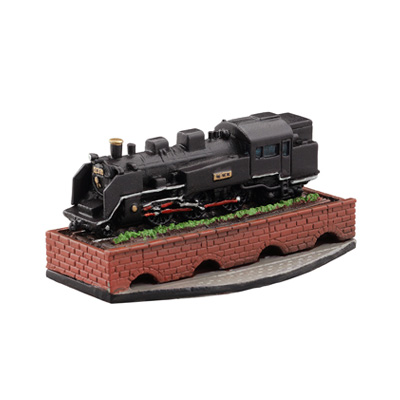
原型制作:寺岡邦明
造形企画制作:株式会社 海洋堂 / 発売日:2016年2月12日 / 価格:1回 400円(税込) / 種類:全6種
-
山手線さんぽフィギュアみやげ / YAMANOTESEN SANPO FIGURE MIYAGE
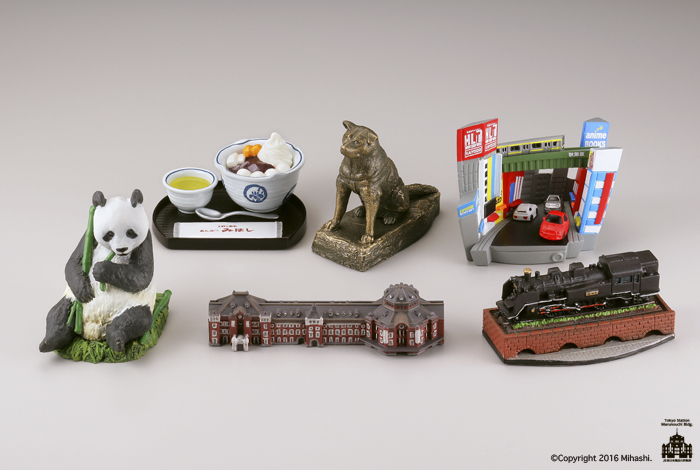
山手線沿線の名所、物産、人物、文化… バラエティ豊かな“山手線名物”を手のひらサイズのフィギュアにしました。
“YAMANOTESEN SANPO FIGURE MIYAGE” is the miniature figures of famous institutions in the area around JR Yamanote Line!

-
造形企画制作:株式会社 海洋堂 / 発売日:2016年2月12日 / 価格:1回 400円(税込) / 種類:全6種